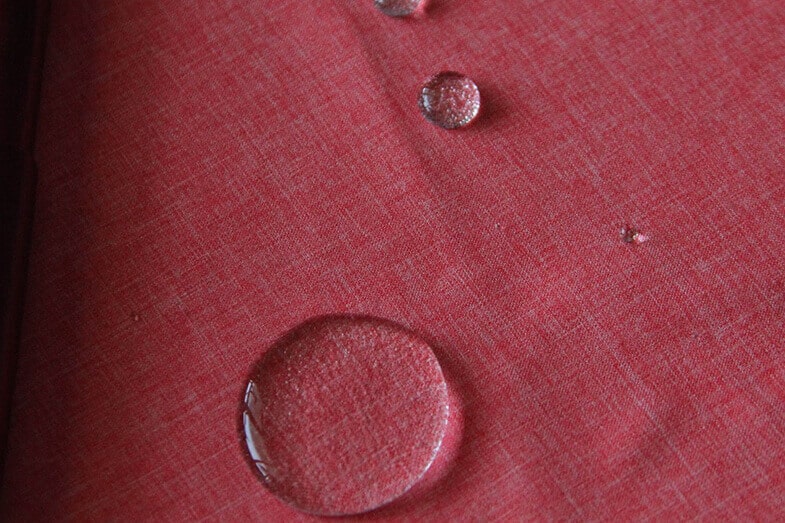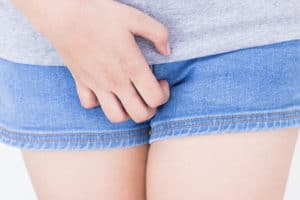If you find a piece of polyester clothing in the store that you really like and you have eczema, just put the clothing down and back away slowly. It’s not worth it; stay clear of polyester, and choose something else that doesn’t have polyester in it! Why is polyester bad for eczema? Is eczema polyester irritation a real thing?
Polyester is bad for eczema. It causes irritation for two reasons:
- It is water-resistant, which means moisture from your sweat cannot escape easily and gets trapped inside.
- It is also made up of many tiny fibers that feel rough and itchy on the skin.
Read on to learn more about “eczema polyester irritation” and why polyester is bad for eczema.
Eczema Polyester Irritation: Why Is Polyester Bad for Eczema?
Polyester is a common irritating substance for those with contact dermatitis.
The two common types of eczema are atopic dermatitis and contact dermatitis.
Those with atopic dermatitis can get eczema flare-ups for many reasons, including contact with an irritant, diet, stress, weather, and more.
Those who only have contact dermatitis can get eczema flare-ups by coming in contact with a specific, irritating substance. These irritating substances can include textiles and fabrics, like polyester or wool; also cosmetics, fragrances, plants, soaps, jewelry, etc.
Sufferers often can determine the cause of the contact dermatitis because it usually appears on parts of the body that have come in contact with the offending substance. For example, if your leg brushes against poison ivy or your wrist is marked red by an irritating watchband. The rash will be red, itchy, dry, and sometimes have bumps, blisters, or swelling. The rash is not contagious or life-threatening, but it is frustrating and uncomfortable.
To treat it, you need to first identify and avoid the cause. If you avoid the problem substance, then the rash will normally clear up in two to four weeks. If the rash doesn’t get better, or it is painful or fast-spreading, it is best to see a doctor.
A doctor may be able to diagnose contact dermatitis and ask you questions to determine the causes and clues of its triggers. To lessen the discomfort, they may prescribe an anti-itch cream or recommend you use cool, wet compresses to soothe the skin. To determine what you are allergic to, they may recommend a patch test.
Small amounts of potential allergens are applied to adhesive patches that are then placed on your back. The patches can be left on for a short while, like 30 minutes, but a proper test involves keeping them on for two to three days. You just must keep your back dry the whole time.
After the allotted time, your doctor will check the skin reactions under the patches to see which caused redness or swelling, and this will show which substances you are allergic to.
This can be done with polyester samples as well. A doctor, during an allergy test, can check how your skin reacts to samples of polyester. If you are like many eczema sufferers, the patch of skin that is tested on will become red, indicating that polyester is a source of contact dermatitis and must be avoided.
Textile Contact Dermatitis – Polyester Eczema Irritation

One of the most common types of contact dermatitis is textile contact dermatitis, also referred to as clothing dermatitis. As the name suggests, it is an allergic reaction caused by wearing clothing or coming into contact with other fabrics.
Textile fiber is categorized as either natural, synthetic (man-made), or a combination of both. Natural fibers include cotton, silk, wool, and linen. Synthetic fibers include polyester, rayon, nylon, spandex, and fiberglass.
Chemical additives used in processing fabric include dyes, glues, tanning agents, and formaldehyde finishing resins. These chemicals are very harsh and nasty if you come in contact directly with them.
Keep in mind that the source of the reaction may not always be the specific textile fabrics but rather the chemical additives or detergent used in the processing of the fabric. For example, cotton is eczema-friendly, but many cotton clothes are treated heavily with chemicals and detergents before packaging and selling them. To lessen the amount of this chemical residue leftover on them, put new clothes in the wash before wearing them.
Textile contact dermatitis symptoms include redness, itchiness, and dry or bumpy skin, including itching in the genital region from irritating undergarments. If you suffer from any of these reactions, avoid wearing offending clothing or coming into contact with the offending substance.
See the below videos for more on contact dermatitis and how it can be trigger from a fabric like polyester:
What Is Polyester?
Polyester is a synthetic fabric that is created by bonding polyester fibers or yarns together. Polyester fibers are made by a chemical reaction between water, air, petroleum, and coal. The process requires lots of energy to produce the plastic polymers, which are pushed through holes to form the fibers.
The fibers are then spun into thread and yarn, then woven into fabric. Polyester fabric is water-resistant and dries quickly. It is also wrinkle-resistant and does not shrink or stretch. It is most commonly found in sporting and outdoor clothing.
Fibers are then spun into thread and yarn, then woven into fabric. Polyester fabric is water-resistant and dries quickly. It is also wrinkle-resistant and does not shrink or stretch. It is most commonly found in sporting and outdoor clothing.
Clothing may be the first to mind when you think of polyester, but it is also used to make those clear plastic water bottles you see everywhere. The polymers are just pulled, stretched, and melted in different ways for the water bottles than they are for fabric.
It is cheap and versatile, and for that reason, it has become ubiquitous in fashion. But the heavy processing required to produce it can cause significant environmental damage. Many companies are now finding ways to create polyester out of recycled plastic bottles or even recycled polyester fabric, so the environmental footprint isn’t as big.
Polyester and Eczema
Polyester fabric is water-resistant, but this means it is moisture-trapping. A moisture-trapping fabric will hold your sweat against your skin and will not let the evaporating moisture escape easily. The result is a warm, clammy garment that holds in your body heat, causing discomfort and irritation of the skin, which can worsen skin issues like eczema.
This water-resistant nature also means bacteria grows on it quicker than other fabrics, which makes it smell and can cause further irritation to the skin. Even after washing, you may notice the fabric still feels like dried sweat is on it or smells musty, which is a sign that there is too much bacteria build-up and should not be worn.
Other than moisture-trapping, another reason polyester can irritate your eczema is that, although it may look smooth, it contains many tiny fibers that be extremely aggravating to sensitive skin.
Like mentioned earlier, you’ll know if you have contact dermatitis from the polyester clothing if, after wearing it, your skin shows signs of tenderness, rashes, redness, hives, and/or itching. These symptoms can become worse if the clothing is tight, not properly washed, poor hygiene, too much moisture, or overheating of the skin.
There are no specific treatments for allergic reactions to polyester, so until then, avoiding it is best. To avoid polyester, always look at the labels on all fabric products, especially taking note of the following:
- Exercise clothing
- Bedding including sheets, pillow slips, and duvets
- Pajamas
- Shirts and blouses
- Khaki pants
Fleece, which is often made with polyester, may be okay if it is cut and finished to be very smooth. It is often smoother than regular polyester fiber fabric. The only issue is the bulkiness. It can bunch up around the shoulders and elbows and can get hot, which irritates the skin. Thin fleece may be okay, especially as a lightweight, cozy top layer when it is cold.
Other Materials That Irritate Eczema
Other than polyester, there are many other fabrics that must be avoided by eczema sufferers at all costs. This includes other synthetic materials similar to polyesters, such as nylon, rayon, and spandex—also wool, denim, and leather.
Wool is loved by many for its natural breathability and ability to wick away moisture; however, anyone with really sensitive or dry skin will tell you wool is a pain in the butt. It is so itchy! Like polyester fibers, but even more so in many cases.
The wool fibers press against the skin, which stimulates the nerve endings, causing irritation and scratching, which leads to the itch-scratch cycle. The same can be said of denim which usually has a very rough feel to it which will irritate the skin. Both wool and denim are also bulky and heavy, which heats the skin up and causes further irritation.
Eczema-friendly Materials
The most popular choice for eczema sufferers is cotton. It is light and lets the skin breathe. Cotton is also hypoallergenic, which means it is relatively unlikely to cause an allergic reaction. It’s very soft, with no rough fibers, unlike found in materials like polyester or in wool.
As mentioned earlier, the issue with cotton can be the harsh chemicals, such as formaldehyde or dyes, it is prewashed or treated in. To avoid this, look for cotton clothing that is organic or says on the label that it is made without harsh chemicals or dyes. Before wearing it, make sure to run it through the wash with an eczema-friendly detergent just to make sure you get rid of any possible chemical residue left behind.
Other than cotton, linen and silk are also safe for eczema-sufferers. They are incredibly light and let the skin breathe easily. Linen, which is a natural textile made from the fibers of the flax plant, does wrinkle easily, which can be frustrating.
Silk, which is a natural fiber made from silkworms, is going to cost a pretty penny. Silk and linen are also both naturally antimicrobial or antibacterial, which means that they don’t provide germs with an ideal breeding environment. This greatly reduces the risk of infections in eczema-prone skin.
Bamboo is another popular alternative to cotton. It is four times more absorbent than cotton and maintains body temperature by wicking away moisture instead of trapping it by the skin. It remains cool to the touch, making it perfect for hot weather.
Bamboo is also naturally antibacterial, which means it has elements that naturally kill the spread of bacteria. As a bonus, it is also one of the most environmentally friendly fibers. Bamboo grows naturally, with ease, without the need for toxic pesticides, and requires limited fertilizers.
A study in the British Journal of Dermatology included 46 children with eczema, randomized into two groups wearing cotton or silk. The only medication used was moisturizer. After one week, there was a big improvement in the children wearing silk versus no change in the eczema of the cotton-wearing children.
New technology in fabric production has led to micro-fiber clothing developed with sensitive skin in mind. These micro-fiber fabrics are usually very smooth, lightweight, and breathable. The downside is that they can be expensive, but they may be worth the investment.
See the below video for more about which fabrics to avoid (like polyester) and choose (like cotton):
Eczema Polyester Irritation Is Common with Babies
Just a quick, final note for parents with babies who have eczema. Eczema is very common in babies, and having a little one suffer through it can be one of the most painful and stressful experiences a parent can go through. The first treatment that comes to mind by the parents is to use a cream or lotion, which is fine, but the right clothing is equally important.
Babies cannot communicate what they are feeling about different types of clothing or fabrics, so if you are a parent, please ensure to use only cotton or silk or a similar eczema-friendly material. And stay clear of polyester and other synthetic materials, as well as itchy wool and denim. If your baby develops inflammation from an irritating material, like polyester, get rid of the irritating fabric and choose 100% cotton instead.
Conclusion – Is Polyester Bad for Eczema?
So is polyester good for eczema? Is polyester bad for eczema?
Polyester is bad for eczema because it is an irritating fabric for those with sensitive skin. It is water-resistant, which means moisture cannot escape easily and gets trapped on your skin which causes irritation. Polyester is also made up of many tiny fibers that feel rough and itchy on sensitive skin.
So to avoid eczema polyester irritation, ditch the polyester and so that you don’t trigger any eczema flare-ups. Instead, choose 100% cotton clothing and bedding. Once your eczema subsides and clears up, you could start wearing polyester from time to time. But you may just find it is best to stick to cotton for good.




![Read more about the article Accutane Eczema [Is Accutane Good or Bad for Eczema?]](https://skincaregeeks.com/wp-content/uploads/2020/12/Accutane-eczema-300x200.jpg)
